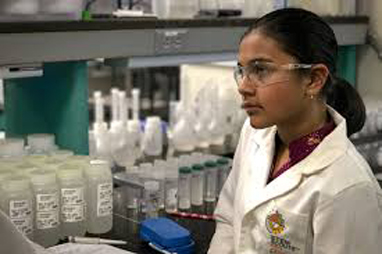
NEW YORK (TIP):Young IndianAmerican scientist Gitanjali Rao, TIME magazine’s first-ever ‘Kid of the Year’, has said she is brainstorming about solutions for the effective vaccine distribution to address a pressing challenge posed by the coronavirus, and has set her sights on preventing future pandemics.
In an interview with PTI, the 15-year-old inventor said she was focused on using technological tools to offer solutions for vaccine distribution, a challenge that confronts the world grappling with the deadly COVID-19 pandemic.
Rao was named by TIME magazine this month as the first-ever ‘Kid of the Year’ for her “astonishing work using technology to tackle issues ranging from contaminated drinking water to opioid addiction and cyberbullying”. She was selected among over 5,000 nominees for the honor.
“I definitely do want to look at the pandemic. The next biggest problem we’re going to face is vaccine distribution and prioritization. So I’m looking at my potential data and analytics approach towards that,” Rao said.
“But I think the next biggest problem that I’ll probably look towards solving is preventing future pandemics from happening because I think it’s safe to assume that this isn’t the last one and we probably will have another one before 100 years,” she said.
Rao says she is still at a “brainstorming and observing” phase but is looking at the whole idea of vaccine distribution and how widespread it needs to be.
“Also, how important it is because everybody needs to receive this vaccine. So, I’m looking at how we can use predictive analytics and data models in order to create a plan of how vaccine distribution will roll out,” she said.
TIME had said in its profile that “exceptional leadership” is what made the “brilliant” Rao stand out for the honor.
“Rao not only researches scientific tools such as artificial intelligence and carbon nanotube sensor technology and applies them to problems she sees in everyday life, like cyberbullying and water contamination. She also shows other kids how to tap into their curiosity, aspiring to create a generation of innovators,” it said.
Rao said it was very “exciting” to be named Kid of the Year “but more than that it’s honoring and humbling to be that face of Generation Z as well as have the opportunity to be featured on the cover of TIME among so many other fantastic people. I’m so beyond humbled and I’m just excited to see where this keeps going”. The youngster, who through her work is an inspiration for many, counted her parents – Bharathi and Ram Rao – and the family as her “biggest inspirations”.
Rao said she had always received an incredible amount of support from her parents. “If I wanted to play a certain sport, learn something new, I had all the resources in front of me,” she said.
Rao recalled how her mother brought nearly a dozen books for her in third grade on clouds when she wanted to learn about the subject. “Experiences like that are what changed my life forever, having that support and being able to do what I love without any backlash,” she said. Rao said she was also “truly inspired” by scientists and inventors who go beyond themselves and innovate for positive change, particularly Jonas Salk, who invented the polio vaccine and never patented it.
“He never claimed it as his own because he wanted it to be something that everyone could use, and I really aspire to be that selfless and put others before me,” Rao said.
The young scientist, who has been featured in Forbes list of 30 Under 30 achievers, was named America’s Top Young Scientist and is a STEM (Science, Technology, Engineering, and Mathematics) promoter, wants to see more young girls being given opportunities to study and work in the field.
“I think another thing is just showing them role models in the field and I honestly aspire to be one of them,” she said, adding that when she was in second grade, she did not know females could be scientists. “I didn’t know it was possible because everybody I had seen in the media and learned about was a male. I was excited personally to learn that a girl could be a scientist which is almost problematic because I was able to learn about that but what if people didn’t have that inspiration, didn’t have that opportunity for growth. We just need to involve more girls in STEM by showing them that they can do it,” she said.
Rao has also been working tirelessly on creating a community of innovators and has so far mentored thousands of students. She runs workshops for students from across the globe who want to become innovators and solve global problems. “Everyone comes out of that workshop with one solution and a process that they can take to implement it in the real world. If I can do it, you can do it and anyone can do it,” she says.
Rao says she is interested in working on several things in the future and wants to look at genetic research with product design involved.
“Hopefully, whatever I’m doing, I’m changing the world for the better,” she said. For Rao, her own passion right now is working on solutions for the contamination of natural resources.
“I’m looking at water contamination specifically and water parasitic contamination is the biggest problem that I’m seeing out there today. I really want to find a way to prevent that from happening,” she said, adding that she is using genetically engineered microbes to detect parasites in water. “I’m using living things to find living things which I think is a very interesting concept,” she said. PTI





Be the first to comment